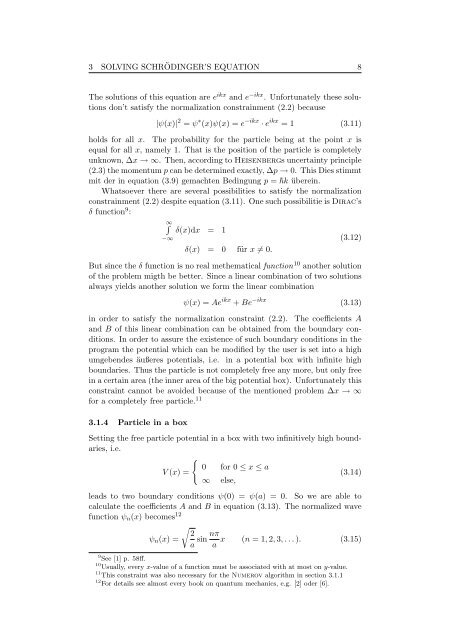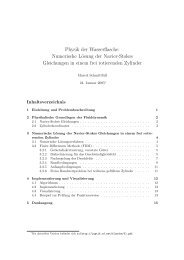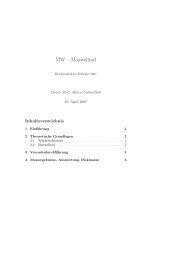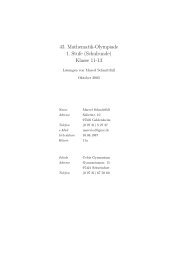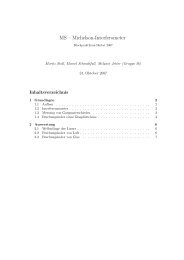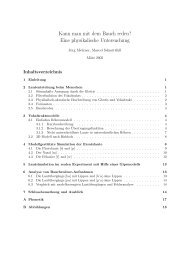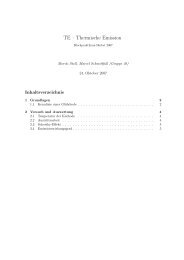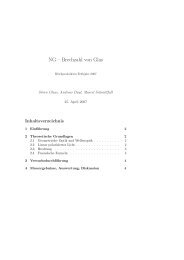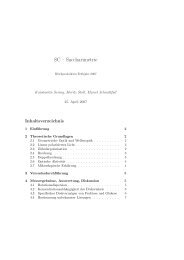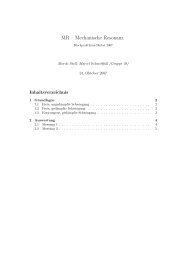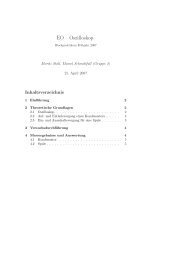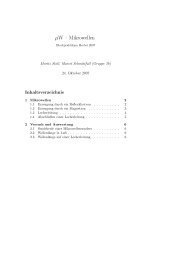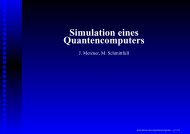JavaPsi - Simulating and Visualizing Quantum Mechanics (english)
JavaPsi - Simulating and Visualizing Quantum Mechanics (english)
JavaPsi - Simulating and Visualizing Quantum Mechanics (english)
Create successful ePaper yourself
Turn your PDF publications into a flip-book with our unique Google optimized e-Paper software.
3 SOLVING SCHRÖDINGER’S EQUATION 8<br />
The solutions of this equation are e ikx <strong>and</strong> e −ikx . Unfortunately these solutions<br />
don’t satisfy the normalization constrainment (2.2) because<br />
|ψ(x)| 2 = ψ ∗ (x)ψ(x) = e −ikx · e ikx = 1 (3.11)<br />
holds for all x. The probability for the particle being at the point x is<br />
equal for all x, namely 1. That is the position of the particle is completely<br />
unknown, ∆x → ∞. Then, according to Heisenbergs uncertainty principle<br />
(2.3) the momentum p can be determined exactly, ∆p → 0. This Dies stimmt<br />
mit der in equation (3.9) gemachten Bedingung p = k überein.<br />
Whatsoever there are several possibilities to satisfy the normalization<br />
constrainment (2.2) despite equation (3.11). One such possibilitie is Dirac’s<br />
δ function9 :<br />
∞<br />
δ(x)dx = 1<br />
−∞<br />
(3.12)<br />
δ(x) = 0 für x = 0.<br />
But since the δ function is no real methematical function 10 another solution<br />
of the problem migth be better. Since a linear combination of two solutions<br />
always yields another solution we form the linear combination<br />
ψ(x) = Ae ikx + Be −ikx<br />
(3.13)<br />
in order to satisfy the normalization constraint (2.2). The coefficients A<br />
<strong>and</strong> B of this linear combination can be obtained from the boundary conditions.<br />
In order to assure the existence of such boundary conditions in the<br />
program the potential which can be modified by the user is set into a high<br />
umgebendes äußeres potentials, i.e. in a potential box with infinite high<br />
boundaries. Thus the particle is not completely free any more, but only free<br />
in a certain area (the inner area of the big potential box). Unfortunately this<br />
constraint cannot be avoided because of the mentioned problem ∆x → ∞<br />
for a completely free particle. 11<br />
3.1.4 Particle in a box<br />
Setting the free particle potential in a box with two infinitively high boundaries,<br />
i.e.<br />
<br />
0 for 0 ≤ x ≤ a<br />
V (x) =<br />
(3.14)<br />
∞ else,<br />
leads to two boundary conditions ψ(0) = ψ(a) = 0. So we are able to<br />
calculate the coefficients A <strong>and</strong> B in equation (3.13). The normalized wave<br />
function ψn(x) becomes12 ψn(x) =<br />
2<br />
a<br />
nπ<br />
sin x (n = 1, 2, 3, . . . ). (3.15)<br />
a<br />
9 See [1] p. 58ff.<br />
10 Usually, every x-value of a function must be associated with at most on y-value.<br />
11 This constraint was also necessary for the Numerov algorithm in section 3.1.1<br />
12 For details see almost every book on quantum mechanics, e.g. [2] oder [6].


